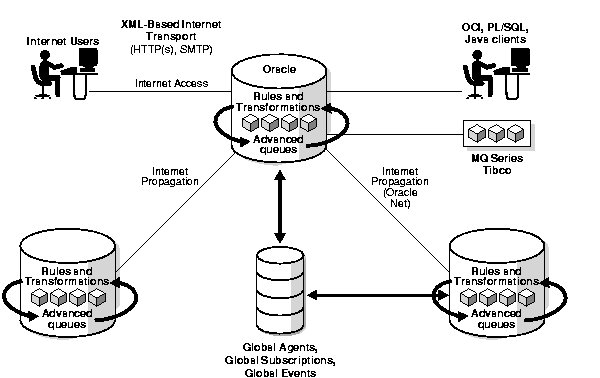Release 1 (9.0.1)
Part Number A88890-02
Home |
Book List |
Contents |
Index | Master Index | Feedback |
| Oracle9i Application Developer's Guide - Advanced Queuing Release 1 (9.0.1) Part Number A88890-02 |
|
Introduction to Oracle Advanced Queuing , 2 of 9
When Web-based business applications communicate with each other, producer applications enqueue messages and consumer applications dequeue messages. Advanced Queuing provides database-integrated message queuing functionality. Advanced Queuing leverages the functions of the Oracle database so that messages can be stored persistently, propagated between queues on different machines and databases, and transmitted using Oracle Net Services (formerly Net8), HTTP(S), and SMTP.
Since Oracle Advanced Queuing is implemented in database tables, all the operational benefits of high availability, scalability, and reliability are applicable to queue data. Standard database features such as recovery, restart, and security are supported in Advanced Queuing, and queue tables can be imported and exported. See Chapter 4, "Managing AQ" for more information. You can also use database development and management tools such as Oracle Enterprise Manager to monitor queues. See "Oracle Enterprise Manager Support" in Chapter 4.
Advanced Queuing provides the message management functionality and asynchronous communication needed for application integration. In an integrated environment, messages travel between the Oracle database server and the applications and users, as shown in Figure 1-1. Using Oracle Net Services (formerly Net8), messages are exchanged between a client and the Oracle database server or between two Oracle databases. Oracle Net Services also propagates messages from one Oracle queue to another. Or, as shown in Figure 1-1, you can perform Advanced Queuing operations over the Internet using transport protocols such as HTTP, HTTPS, or SMTP. In this case, the client, a user or Internet application, produces structured XML messages. During propagation over the Internet, Oracle servers communicate using structured XML also. See Chapter 17, "Internet Access to Advanced Queuing" for more information on Internet integration with Advanced Queuing.

Text description of the illustration adq81437.gif
You can access Advanced Queuing functionality through the following interfaces:
DBMS_AQ, DBMS_AQADM, and DBMS_AQELM. See the Oracle9i Supplied PL/SQL Packages and Types Reference.
oracle.AQ Java package. See the Oracle9i Supplied Java Packages Reference.
oracle.jms Java package. See the Oracle9i Supplied Java Packages Reference.
Advanced Queuing meets queuing system requirements for performance, scalability, and persistence. See Chapter 5, "Performance and Scalability" for more information.
Requests for service must be decoupled from supply of services to increase efficiency and provide the infrastructure for complex scheduling. Advanced Queuing exhibits high performance characteristics as measured by the following metrics:
Queuing systems must be scalable. Advanced Queuing exhibits high performance as the number of programs using the application increases, as the number of messages increases, and as the size of the message warehouse increases.
Messages that constitute requests for service must be stored persistently, and processed exactly once, for deferred execution to work correctly in the presence of network, machine, and application failures. Advanced Queuing is able to meet requirements in the following situations:
Queuing systems need message persistence so they can deal with priorities: messages arriving later may be of higher priority than messages arriving earlier; messages arriving earlier may have to wait for messages arriving later before actions are executed; the same message may have to be accessed by different processes; and so on. Priorities also change. Messages in a specific queue can become more important, and so need to be processed with less delay or interference from messages in other queues. Similarly, messages sent to some destinations can have a higher priority than others.
Message persistence is needed to preserve message metadata, which can be as important as the payload data. For example, the time that a message is received or dispatched can be a crucial for business and legal reasons. With the persistence features of Advanced Queuing, you can analyze periods of greatest demand or evaluate the lag between receiving and completing an order.
|
|
 Copyright © 1996-2001, Oracle Corporation. All Rights Reserved. |
|